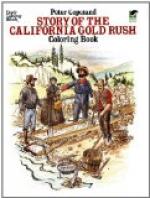Down on the mud-flats at low tide you see birds called rails, and also “kill-dee” plovers. The shoveller ducks are there, too fishing up with broad, flat beaks little crabs and such creatures as are in the mud, straining out mud and water, but swallowing the rest. All these birds are “waders” and delight in mud and cold salt water. They are usually quiet, or make only strange, shrill cries.
In the sunny fields and woods we shall find many of the land-birds, and first comes a family whose habits are so like those of chickens that they are called “scratchers.” These birds depend for food upon seeds and bugs or worms they scratch out of the ground. Up in the Sierra sugar-pines and fir-woods lives the largest of these “scratchers,” the brown grouse. He is a shy creature, rising out of his feeding-ground with a great whirring of wings and out of sight before the hunter can fire at him. His peculiar cry, or “drumming,” as it is called, sounds through the woods like tapping hard on a hollow log. His equally shy neighbor is the mountain-quail, while through the farming lands and all along the hillsides the valley—quail are plenty. Perhaps you have seen a happy family of these speckled brown birds. Papa quail has a black crest on his head, and he calls “Look right here” from the wrong side of the road to fool you, while Mamma and her little, cunning chicks scatter like flying brown leaves in the brush. After the danger is past, you hear her low call to bring them round her again. In the desert and sage-brush part of the state the sage-hen, another “scratcher,” runs swiftly through the thickets, but many are caught and brought in by the Indians.
Our birds of prey are eagles, vultures, hawks, owls, and the turkey-buzzards, those big black scavengers that hang in the air. In circles high above woods and fields some of these birds of prey sweep on broad wings, searching with keen sight for their food in some dead animal far below. The California condor, a great black vulture-like bird, is almost extinct, and is only found in the highest mountains. It is very large of wing, and strong enough, it is said, to carry off a sheep. Both golden and bald eagles nest in tall trees in the wildest parts of the state. The chicken-hawk, whose swift sailing over the poultry-yard calls out loud squawking from the frightened hens, you have often seen, and the wise-looking brown owls, too. A small burrowing owl lives in the squirrel holes, and you may catch him easily in the daytime, when he cannot see.
The road-runner is of the cuckoo family of birds. It seldom flies, but runs swiftly along the roads, or in the desert, and is said to kill rattlesnakes by placing a ring of thorny cactus leaves around the snake as it lies asleep. The rattler is then pecked to death, since it cannot get out of its prickly cage. This fowl is like a slender brown hen in size.
In the redwoods you hear the tap, tap, of the “carpenter” woodpecker, with his black coat and gay red cap. He drills holes in the bark of a tree with his strong beak and then fits an acorn neatly into each safe little storehouse. It is thought that worms and grubs fatten while living in these acorns, so that the woodpecker always has a meal ready in the winter when the ground is wet, or the squirrels have carried off the acorns under the trees.




